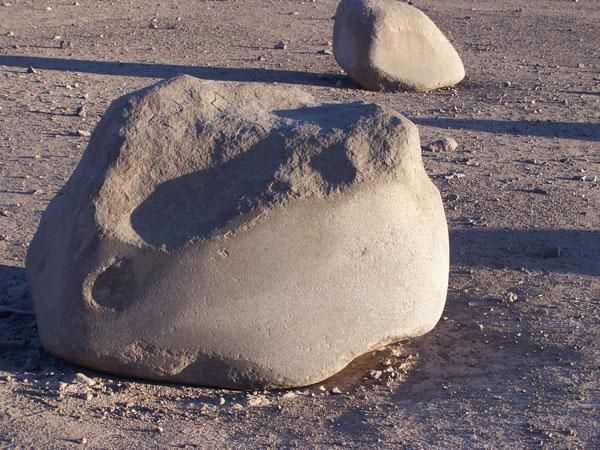
Rocking Find: Boulders Rub Shoulders During Quakes

A strange geological process is at work in a remote corner of northern Chile's Atacama Desert, and it was discovered thanks to one scientist's upset stomach.
University of Arizona geologist Jay Quade were traveling through the area when Quade's sour stomach forced them to stop their truck at a lifeless expanse of boulders in the Atacama that they had passed before without noticing anything unusual.
While the others wandered off to see the sites, as geologists are wont to do, Quade climbed under the truck to get out of the beating sunlight. That's when Quade noticed something very unusual about the half-ton to 8-ton boulders near the truck: they appeared to be rubbed very smooth about their midsections.
The most common agent of such erosion is water not something readily found in the bone-dry Atacama. [Related: 10 Driest Places on Earth ]
About the only other thing that came to Quade's mind was earthquakes, he said in a statement. Over the approximately two million years that these rocks have been sitting on their sandy plain perhaps they were jostled by seismic waves that caused them to gradually grind against each other and smooth their sides. It made sense, but Quade never thought he'd be able to prove it.
Boulder surfing
Then, on another trip to the Atacama, Quade was standing on one of these boulders, pondering their histories when a 5.3 magnitude earthquake struck. The whole landscape started moving and the sound of the grinding of rocks was loud and clear.
Sign up for the Live Science daily newsletter now
Get the world’s most fascinating discoveries delivered straight to your inbox.

"It was this tremendous sound, like the chattering of thousands of little hammers," Quade said. He'd probably have made a lot more observations about the minute-long event, except he was a bit preoccupied by the boulder he was standing on, which he had to ride like a surfboard.
"The one I was on rolled like a top and bounced off another boulder. I was afraid I would fall off and get crushed," he said. The experience solidified the theory for Quade, who is presented his findings today at the annual meeting of the Geological Society of America in Minneapolis.
"I was just astonished when this earthquake came along and showed us how it worked," Quade said.
A seismic solution
The whole story appears to be that the boulders tumbled down from the hills above probably dislodged by earthquakes. They accumulated on the sand flat, with no place else to go. Quade compares the situation to a train station where people are crowded together closely, rubbing shoulders as they waiting for a train. In this case the boulders have been stuck at the station for hundreds of millennia and the train never comes. So they just get more crowded and rub shoulders more over time.
Analyses of the boulder top surfaces suggest that they have been there one to two million years. That age, combined with the fact that seismic activity in the area generates a quake like that Quade witnessed on the average of once every four months, suggests that the average boulder has experienced 50,000 to 100,000 hours of bumping and grinding during its time on the flats.
And the earthquakes aren't the only mystery about the boulders that is solved by this theory.
"It also answers a mystery that had been eating at me for years: How do the boulders get transported off the hills when there is so little rain," Quade said. "How do you erode a landscape that is rainless?"












